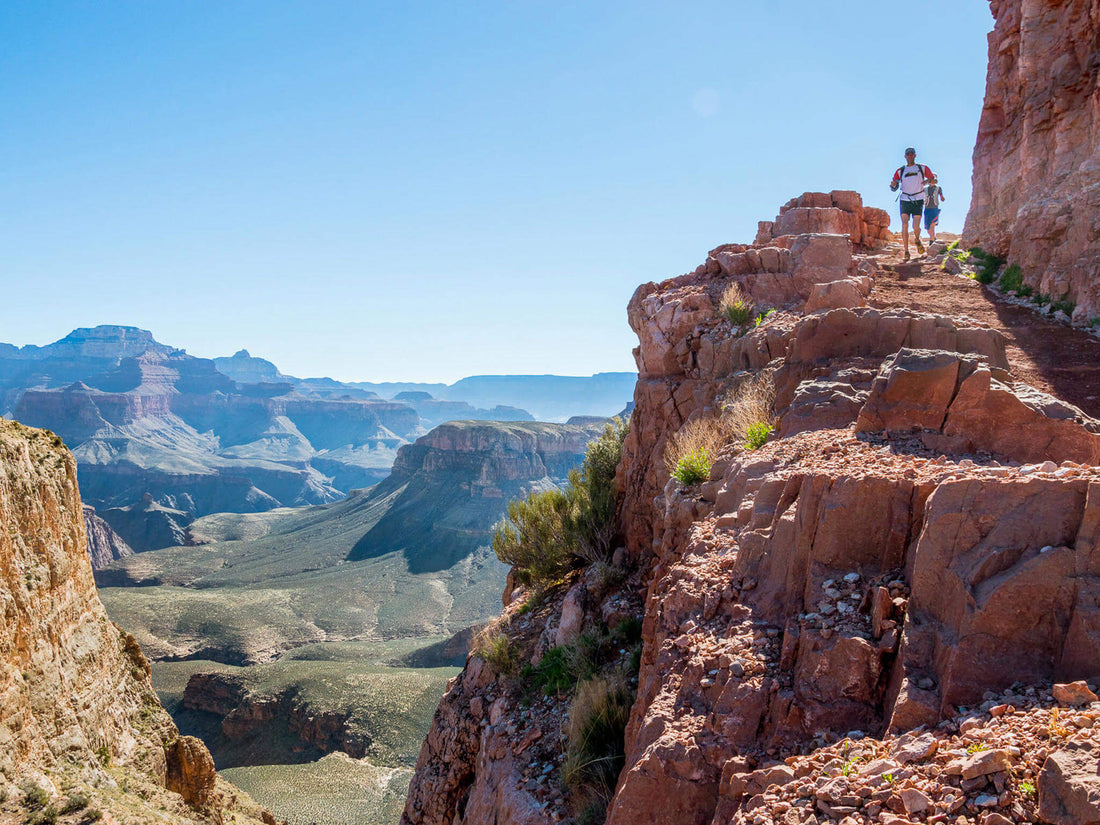A place so physically unique and geographically huge as the Grand Canyon is many different things to different people. Photographers come for colors and changing light, backpackers for solitude and sleeping under the stars, and hikers for the challenge of linking rim and river within a day. Runners come to see just how fast they can do it all.
The Grand Canyon is a proving ground for athletes. Between the two rims lies a literal gauntlet to be run. Trails here offer the potential for more than two vertical miles of gain within a day—a novelty that is simply not possible most places in the world.
The ultimate feat is “Rim-to-Rim-to-Rim” (R2R2R)—getting from one side, down to the river, up to the opposite side, and back again, in one day. This means more than 40 miles and more than 20,000 feet of up and down.
The R2R2R should not be attempted as your first run in the canyon, and it doesn’t have to be. Running here is not exclusively for the elite. By choosing your route, pacing carefully, and packing accordingly, runners of all abilities can experience “light and fast” trail run. A network of trails makes it possible to tailor distance and terrain, though running here is never easy.
Where to Run

Running along the top avoids the canyon’s typical rigors, but may still feel challenging because of altitude and heat. Rim Trail on South Rim offers spectacular views and is paved for some of the way. North Rim has many trails that stay on top, providing a variety of scenery and distances.
To really run the canyon, though, you have to drop below the rim. Runners usually take the “corridor” trails—South Kaibab, Bright Angel (both South Rim), or North Kaibab (North Rim) because they are wide and well-maintained. To avoid crowds, start earlier than 8 a.m.
The best trail for running is Tonto Trail (South Rim), a single track with rolling hills instead of constant up or down. Getting to it still requires serious elevation change, however, because it is more than halfway down from the rim.
Trail Etiquette

Most hikers are on the trail for a once-in-a-lifetime challenge and don’t expect to see people running it. Therefore, it is particularly important to practice proper trail etiquette. As with any other trails, be courteous and yield to uphill traffic. When passing, always give an audible, polite heads up. Many of the dropoffs are dangerous, so you should always be willing to pass hikers on the outside, but carefully move to whichever side they allow you.
Mules always have right of way, no matter what. Getting stuck behind a mule train is a runner’s biggest headache, especially when going downhill. Unfortunately you have no choice but to wait for the mule driver to stop his team and let hikers pass. Always walk past mules, don’t run because if they get startled they may throw their rider.
How to Prepare

More so in the Grand Canyon than anywhere else, preparation is key. This landscape presents certain physical and logistical difficulties not always encountered elsewhere. Pushing too fast or too far can land you out of help’s reach. A bonk or injury in the Grand Canyon can’t be fixed by hitching a ride, or by using the cell phone to call for help. Even walking it out may prove too difficult if you get in trouble thousands of feet below the rim. Another concern is water and nutrition. Many trails have no water available, and others have water that must be treated. Plan your route based on availability of drinking water (see day hiking for more information on water sources). Despite the feeling of thirst, you should consume lots of salty snacks and energy fuels, because the body constantly loses essential electrolytes to perspiration in the dry air. In general, plan to consume twice as much food and water in the Grand Canyon than you would on a run elsewhere, and this is no joke. Runners have died from dehydration and from hyponatremia (low sodium).
Weather is always a factor for running, and especially so in the extremes of the Grand Canyon. Some days can be oppressively hot at the river while snowing on the rim because of the huge difference in elevation. Depending on the season, you may want to pack layers of clothing. Winter brings ice and summer brings thunderstorms, so always be aware of conditions.
The Grand Canyon is becoming a more popular running destination for its beauty and novelty, but its difficulty must never be underestimated. This is a great place to get a workout, but no place to test your limits. Plan carefully, pack accordingly, listen to your body, and you will have the run of your life in the Grand Canyon.
